Project Summary
2015-2020
The prohibition dominated approach to non-medical and non-scientific use of certain psychoactive substances is a long-standing feature of international drug policy, but the trade in drugs online is a relatively new feature. Historic interventions by state and international law enforcement agencies against online drug transactions on the clearnet, combined with the increasingly de-anonymised nature of the internet in general, have driven the online drug trade underground, into cryptographically obscured spaces on the darknet. The growing trade in narcotics being sold over Crypto-Drug Markets (CDMs) is causing academics, law enforcement and policy makers to reassess the impact of ICT technology on drug policy enforcement. The CDM project page aims to provide a useful resource for those attempting to understand the complicated nexus of drug policy and the internet.
Technical Advisors
Project Lead: Martin Horton-Eddison

All GDPO material published on this website is licensed under a CC-BY Creative Commons Attribution 4.0 International License.
Drug Cryptomarkets in the 2020s:
Policy, Enforcement, Harm, and Resilience
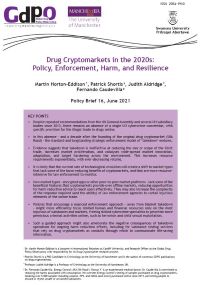
GDPO & University of Manchester, Policy Brief 16, June 2021
Martin Horton-Eddison, Patrick Shortis, Judith Aldridge, Fernando Caudevilla
This GDPO Policy Brief is intended to inform policy-makers, practitioners, and other actors of the latest developments – and likely future direction – of Drug Cryptomarkets (DCM). It draws together several complementary active research strands to provide a timely trend analysis of the current and future state of the DCM landscape, clarifies the impact of a decade of counter-DCM policy and enforcement strategy on market development, and proposes suggestions for future enforcement strategies and wider policy guidance for the coming decade.
Read the full Policy Brief: Drug Cryptomarkets in the 2020s: Policy, Enforcement, Harm, and Resilience
Seoul Searching: South Korea’s AI Counter-Cryptomarket
Capability and Associated
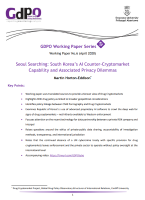
GDPO Working Paper 6, April 2020
Horton-Eddison, M.
Despite recent increases in Russian and Chinese markets and vendors, much analysis of Drug Cryptomarket (DCM) policy and enforcement operations has been largely focused on English language markets either located in, or serving, buyers in North West Europe, North America, and Australasia. However, the Republic of Korea (ROK) has been quietly developing – in conjunction with domestic academic and corporate partners – highly sophisticated counter-crypto capabilities. By March 2020, ROK technologies were so advanced that Seoul-based S2W Lab were invited to enter a technology-for-data partnership with Interpol. The year-long arrangement formalised mass data sharing between the ostensibly private organisation and international law enforcement. How – and why – the Republic of Korea has moved so far forward in counter-crypto enforcement capabilities is worthy of attention.
Read the full analysis here: Seoul Searching: South Korea’s AI Counter-Cryptomarket Capability
Crypto-Market Enforcement - New Strategy and Tactics
 GDPO Situation Analysis, June 2018
GDPO Situation Analysis, June 2018
Alois Afilipoaie and Patrick Shortis
Between June and July 2017, two law enforcement actions targeted the cryptomarkets AlphaBay and Hansa Market, closed them, and arrested their operators, seizing millions of dollars in assets in the process. These operations, dubbed ‘Operation Bayonet’ (AlphaBay) and ‘Operation GraveSac’ (Hansa) saw a shift in the strategy and tactics that law enforcement agencies are using to target cryptomarket activity on the Tor network.4 By deconstructing the operation, this situational analysis aims to provide pertinent lessons on how law enforcement agencies have adapted their approach towards tackling cryptomarkets.
Hard Interventions and Innovation in Crypto-Drug Markets: The escrow example
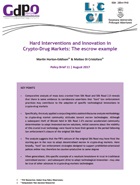 GDPO Policy Brief 11, August 2017
GDPO Policy Brief 11, August 2017
Martin Horton-Eddison & Matteo Di Cristofaro
This policy brief uses empirical study to test the hypothesis that so-called ‘hard’ law enforcement operations (i.e. site takedowns) are a significant cause for innovation of dark net drug market technologies. Comparative analysis of mass data crawled from Silk Road and Silk Road 2.0 appears to corroborate the idea that law enforcement takedowns play a catalytic role in innovation of market technologies. It therefore raises questions over the long-term efficacy of ‘hard’ law enforcement strategies on the dark net, if those actions are intended to curb usage of CDM for drug transactions. The research highlights the potentially counterproductive nature of takedowns in particular. Policy practitioners may therefore ask a recurring question; just as in traditional drug markets, do short-term results, necessarily mean long term successes?
Read the full brief here: Hard Interventions and Innovation in CryptoDrug Markets The escrow example
Updating Escrow: Demystifying the CDM multisig process
 GDPO Situation Analysis, June 2017
GDPO Situation Analysis, June 2017
Martin Horton-Eddison
Until now, the Crypto-Drug Market (CDM) escrow process has been described according to a historic centralised escrow system. However, centralised escrow is fast becoming obsolete, with four of the five most popular current CDMs now offering a form of decentralised escrow, known as multisignature (multisig). Multisig is therefore rapidly becoming the industry standard for ameliorating financial risk in CDM transactions. This Situation Analysis is intended to clarify the multisig process. It presents an analysis of the background to the shift toward decentralisation, a description of the new process, and a diagrammatic representation of the multisig escrow model.
Read the full analysis here: Updating Escrow Demystifying the CDM multisig process
Corpus Linguistics Methodology on the Silk Road(s): The Escrow Example
 GDPO Situation Analysis, June 2017
GDPO Situation Analysis, June 2017
Matteo Di Cristofaro & Martin Horton-Eddison
This Situation Analysis is a methodological paper intended to supplement the research findings presented in GDPO Policy Brief 11, Horton-Eddison, M. & Di Cristofaro, M., Hard Interventions and Innovation in Crypto-Drug Markets
Subject: The application of Corpus Linguistics to the concept of innovation in crypto-drug markets. This analysis shows the application of Corpus Linguistics methodology and of CADS (Corpus Assisted Discourse Studies) approach to data extracted from Crypto-Drug Market (CDM) communities. The aim is twofold: First, to demonstrate how the analysis of textual data created by CDM users can help pin-point the impact that ‘real-life’ events (in this case, the FBI’s seizure and closure of Silk Road, and the theft of a substantial amount of Bitcoin on Silk Road 2) have on online crypto-communities. Second, to illustrate how linguistics theories and methodologies may be used to investigate how ‘trust’ is established/reinforced in online CDM communities.
Read the full analysis here: Corpus Linguistics Methodology on the Silk Road The Escrow Example
From Dealer to Doorstep – How Drugs Are Sold On the Dark Net
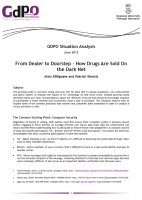
Alois Afilipoaie and Patrick Shortis
The growing trade in narcotics being sold over the Tor Dark Net is causing academics, law enforcement and policy makers to reassess the impact of ICT technology on real-world crime. Despite growing media attention there are many misconceptions about the difficulty involved and technical knowledge required to participate in these markets and successfully make a sale or purchase. This Situation Analysis aims to explain some of the common practices that vendors and customers alike undertake in order to conduct a secure purchase or sale.
Read the full analysis here: From Dealer to Doorstep – How Drugs Are Sold On the Dark Net
The Booming Market of Alternative Cryptocurrencies
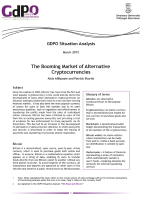 GDPO Situation Analysis, March 2015
GDPO Situation Analysis, March 2015
Alois Afilipoaie and Patrick Shortis
Since its creation in 2009, Bitcoin1 has risen to be the first and most popular cryptocurrency in the world and has led to the development of many other alternative cryptocurrencies (or Altcoins) looking to stake their claim in a new and fast-moving financial market. It has also been the most popular currency of choice for users of Dark Net markets due to its semianonymous qualities, lack of regulation and effectiveness in laundering the profits made from the sales of contraband online. However, Bitcoin has been criticised by users of the Dark Net as lacking genuine anonymity and providing a trail of evidence for law enforcement to trace payments via its blockchain. This has led to an increase in the development of alternative cryptocurrencies (Altcoins) in which anonymity and security is prioritised in order to make the tracing of payments and laundering of proceeds almost impossible.
Read the full analysis here: The Booming Market of Alternative Cryptocurrencies
Operation Onymous: International law enforcement agencies target the Dark Net in
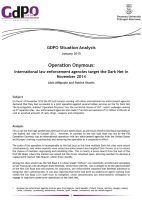 GDPO Situation Analysis, January 2015
GDPO Situation Analysis, January 2015
Alois Afilipoaie and Patrick Shortis
On the 6th of November 2014 the FBI and Europol working with other international law enforcement agencies declared that they had succeeded in a joint operation against several hidden services on the Tor Dark Net. The investigation, dubbed ‘Operation Onymous’ saw the successful closure of 267 ‘.onion’ webpages making up 27 separate sites. Law enforcement agencies also made 17 arrests and seizures of $1 million in Bitcoin as well as assorted amounts of cash, drugs, weapons and computers.
Read the full analysis here: Operation Onymous: International Law Enforcement Agencies Target the Dark Net
The Growing Industry of Darknet Marketing
 GDPO Situation Analysis, January 2015
GDPO Situation Analysis, January 2015
Alois Afilipoaie and Patrick Shortis
Tor’s hidden services have allowed a new form of low-risk high-profit drug dealing to emerge and grow quickly over the last four years. Vendors of narcotics are utilising innovative marketing techniques that mirror those used by legal, ‘real-world’ and web-based businesses to promote and sell goods and services. These range from offers of free samples and discounts, to the use of banner adverts and brand management. Drug marketing is becoming increasingly sophisticated as more users and buyers flock to the Tor network and as hidden markets become more diversified and competitive.
Read the full analysis here: The Growing Industry of Darknet Marketing
A year since the closure of Silk Road: Snapshot of evolved Dark Net drug markets
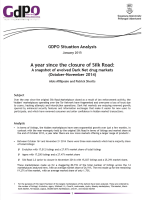 GDPO Situation Analysis, January 2016
GDPO Situation Analysis, January 2016
Alois Afilipoaie and Patrick Shortis
Over the year since the original Silk Road Marketplace closed as a result of law enforcement activity, the ‘hidden’ marketplaces operating over the Tor Network have fragmented and overcome a loss of trust due to scams, hacking attempts and interdiction operations. Dark Net markets are enjoying renewed growth, spurred by enhanced security features and information exchanges that make it easier for new users to participate, and which have renewed consumer and seller confidence in hidden market transactions.
Read the full analysis here: A year since the closure of Silk Road Snapshot of evolved Dark Net drug markets
Silk Road: After being closed twice, can the brand ever ‘rise again?’
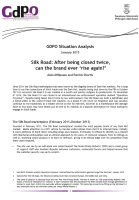 GDPO Situation Analysis, January 2015
GDPO Situation Analysis, January 2015
Alois Afilipoaie and Patrick Shortis
Since 2011 the Silk Road marketplace has been known as the flagship brand of Dark Net markets. For a long time it was the cornerstone of illicit trade over the Dark Net, despite being shut down by the FBI in October 2013 its successor Silk Road 2.0 was created in a month and quickly outgrew its predecessor. On November 6th 2014, the Silk Road 2.0 was closed in an international law enforcement operation dubbed ‘Operation Onymous’1 . Despite being taken down twice by law enforcement, the Silk Road was both a pathfinder and a trend-setter in the world of Dark Net markets. As a brand it will never be forgotten and may possibly continue to rise repeatedly as a hidden service on the Tor network, however as a marketplace the damage done by two busts may have finally put an end to its viability as a popular destination for those looking to engage in illicit trade.
Read the full analysis here: Silk Road After being closed twice, can the brand ever ‘rise again’
Vienna NGO Committee on Drugs
CND thematic Intersessional October 2021 - Intervention from the Global Drug Policy Observatory addressing the challenge that "the criminal misuse of information and communications technologies for illicit drug-related activities is increasing".
Follow the GDPO on social media

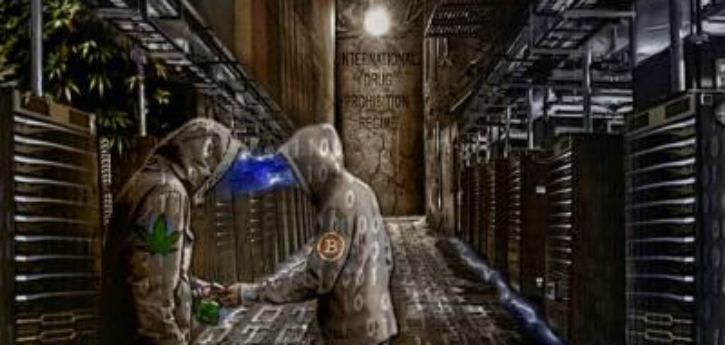



 GDPO Situation Analysis, June 2018
GDPO Situation Analysis, June 2018







